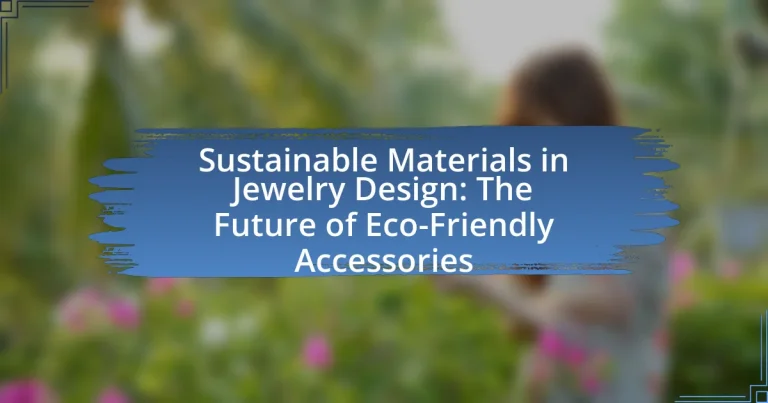Sustainable materials in jewelry design refer to eco-friendly resources that minimize environmental impact and promote ethical practices, including recycled metals, lab-grown gemstones, and organic materials. The article explores the importance of sustainability in the jewelry industry, highlighting the environmental consequences of traditional production methods and the growing consumer demand for responsible products. It discusses various sustainable materials, their benefits, and the challenges faced in sourcing them, while also examining the role of education and collaboration in fostering sustainable practices. Additionally, the article looks at future trends and innovations in eco-friendly accessories, emphasizing the need for transparency and ethical sourcing in jewelry design.

What are Sustainable Materials in Jewelry Design?
Sustainable materials in jewelry design are eco-friendly resources that minimize environmental impact and promote ethical practices. These materials include recycled metals, such as gold and silver, which reduce the need for mining and conserve natural resources. Additionally, lab-grown gemstones offer a conflict-free alternative to mined stones, ensuring ethical sourcing. Organic materials like sustainably sourced wood, bamboo, and natural fibers also contribute to sustainability by being biodegradable and renewable. The use of these materials not only supports environmental conservation but also aligns with consumer demand for responsible and ethical products in the jewelry industry.
Why is sustainability important in jewelry design?
Sustainability is important in jewelry design because it minimizes environmental impact and promotes ethical practices. The jewelry industry has historically contributed to significant ecological degradation and human rights violations, particularly in mining practices. For instance, the extraction of precious metals and gemstones often leads to habitat destruction and pollution. By prioritizing sustainable materials, designers can reduce carbon footprints and support fair labor practices, as seen in the rise of recycled metals and ethically sourced gemstones. This shift not only addresses consumer demand for responsible products but also aligns with global efforts to combat climate change and promote social equity.
What environmental impacts does traditional jewelry production have?
Traditional jewelry production has significant environmental impacts, primarily due to mining practices and resource extraction. Mining for precious metals and gemstones often leads to habitat destruction, soil erosion, and water pollution. For instance, gold mining can produce up to 20 tons of waste for every ounce of gold extracted, resulting in toxic runoff that contaminates local water sources. Additionally, the use of harmful chemicals, such as cyanide and mercury, in the extraction process poses severe risks to ecosystems and human health. These practices contribute to biodiversity loss and long-term environmental degradation, highlighting the urgent need for sustainable alternatives in jewelry design.
How does consumer demand influence sustainable practices in jewelry?
Consumer demand significantly influences sustainable practices in jewelry by driving brands to adopt eco-friendly materials and ethical sourcing methods. As consumers increasingly prioritize sustainability, jewelry companies respond by integrating recycled metals, lab-grown gemstones, and fair-trade practices into their supply chains. For instance, a 2021 survey by the Gemological Institute of America found that 71% of consumers are willing to pay more for sustainable jewelry, indicating a clear market trend towards environmentally responsible options. This shift compels manufacturers to innovate and align their offerings with consumer values, ultimately promoting a more sustainable jewelry industry.
What types of sustainable materials are commonly used in jewelry?
Commonly used sustainable materials in jewelry include recycled metals, ethically sourced gemstones, lab-grown diamonds, and organic materials such as wood and bamboo. Recycled metals, such as gold and silver, reduce the need for mining, which can be environmentally damaging. Ethically sourced gemstones are obtained through responsible mining practices that prioritize environmental and social standards. Lab-grown diamonds offer a conflict-free alternative to mined diamonds, as they are created in controlled environments with minimal ecological impact. Organic materials like wood and bamboo provide biodegradable options, further enhancing the sustainability of jewelry products.
What are the benefits of using recycled metals in jewelry design?
Using recycled metals in jewelry design significantly reduces environmental impact by minimizing the need for new mining, which is resource-intensive and harmful to ecosystems. Recycled metals require less energy to process compared to virgin materials; for instance, recycling aluminum saves up to 95% of the energy needed to produce new aluminum from bauxite ore. Additionally, utilizing recycled metals can lower production costs, making sustainable jewelry more accessible to consumers. This practice also promotes a circular economy, encouraging responsible consumption and waste reduction, which aligns with growing consumer demand for eco-friendly products.
How do lab-grown gemstones compare to natural stones?
Lab-grown gemstones are chemically and physically identical to natural stones, but they are created in controlled environments using advanced technology. Unlike natural stones, which take millions of years to form, lab-grown gemstones can be produced in a matter of weeks, resulting in a more sustainable option with a lower environmental impact. Additionally, lab-grown gemstones often come with a lower price point, making them more accessible to consumers. According to a report by the Gemological Institute of America, lab-grown diamonds, for example, can be up to 30-40% less expensive than their natural counterparts while maintaining the same quality and appearance.
How can sustainable materials enhance jewelry design aesthetics?
Sustainable materials enhance jewelry design aesthetics by offering unique textures, colors, and finishes that are often not found in traditional materials. For instance, recycled metals can provide a distinctive patina, while ethically sourced gemstones can exhibit vibrant hues that reflect their natural origins. Additionally, the use of sustainable materials aligns with contemporary consumer values, making the jewelry more appealing to environmentally conscious buyers. Research indicates that 66% of consumers are willing to pay more for sustainable brands, which underscores the aesthetic and market value of incorporating eco-friendly materials into jewelry design.
What innovative techniques are used to incorporate sustainable materials?
Innovative techniques used to incorporate sustainable materials in jewelry design include the use of recycled metals, lab-grown gemstones, and bio-based materials. Recycled metals, such as gold and silver, reduce the need for mining and lower environmental impact, as evidenced by the fact that recycling one ton of gold can save up to 20 tons of waste. Lab-grown gemstones, which are chemically identical to natural stones, offer a sustainable alternative that eliminates the ethical concerns associated with mining. Additionally, bio-based materials, such as plant-based resins and sustainably sourced wood, provide eco-friendly options that minimize reliance on non-renewable resources. These techniques collectively contribute to a more sustainable jewelry industry by reducing waste and promoting ethical sourcing practices.
How do sustainable materials affect the overall value of jewelry pieces?
Sustainable materials significantly enhance the overall value of jewelry pieces by appealing to environmentally conscious consumers and promoting ethical practices. The use of recycled metals and ethically sourced gemstones not only reduces environmental impact but also aligns with the growing demand for transparency in the supply chain. According to a 2021 survey by the Gemological Institute of America, 71% of consumers are willing to pay more for jewelry made from sustainable materials, indicating a direct correlation between sustainability and perceived value. This trend reflects a shift in consumer preferences towards products that support social responsibility and environmental stewardship, ultimately increasing the market value of jewelry crafted from sustainable resources.

What are the Challenges of Using Sustainable Materials in Jewelry Design?
The challenges of using sustainable materials in jewelry design include limited availability, higher costs, and potential quality issues. Limited availability arises because sustainable materials, such as recycled metals or ethically sourced gemstones, are not as widely produced or distributed as conventional materials. Higher costs are often associated with the sourcing and processing of sustainable materials, which can deter designers and consumers alike. Additionally, quality issues may occur, as some sustainable materials may not meet the same durability or aesthetic standards as traditional options, leading to concerns about the longevity and appeal of the final product. These factors collectively hinder the widespread adoption of sustainable practices in the jewelry industry.
What are the common misconceptions about sustainable jewelry materials?
Common misconceptions about sustainable jewelry materials include the belief that all recycled materials are environmentally friendly and that sustainable jewelry is always more expensive. Many consumers assume that recycled metals, while better than newly mined ones, can still have significant environmental impacts due to the energy used in processing. Additionally, the perception that sustainable jewelry is prohibitively costly overlooks the fact that many sustainable practices can reduce costs over time, such as using locally sourced materials. According to a report by the World Gold Council, responsibly sourced gold can be competitively priced with traditional gold, debunking the myth that sustainability equates to higher prices.
How do cost factors influence the adoption of sustainable materials?
Cost factors significantly influence the adoption of sustainable materials in jewelry design by determining the financial feasibility for manufacturers and consumers. Higher initial costs associated with sustainable materials, such as recycled metals or ethically sourced gemstones, can deter manufacturers from integrating these options into their production processes. For instance, a study by the Ellen MacArthur Foundation highlights that sustainable materials often require more expensive sourcing and processing methods compared to conventional materials, leading to increased retail prices. Consequently, consumers may opt for cheaper, non-sustainable alternatives, impacting the overall market demand for eco-friendly accessories.
What are the limitations of sourcing sustainable materials?
The limitations of sourcing sustainable materials include higher costs, limited availability, and potential quality issues. Sustainable materials often require more expensive production processes, which can increase the overall cost of the final product. Additionally, the supply chain for these materials may not be as developed as for conventional materials, leading to challenges in sourcing and consistency. For example, organic cotton and recycled metals may not be as readily available as traditional materials, impacting production timelines. Furthermore, some sustainable materials may not meet the same durability or aesthetic standards as their non-sustainable counterparts, which can affect consumer acceptance and marketability.
How can designers overcome challenges in sustainable jewelry production?
Designers can overcome challenges in sustainable jewelry production by adopting innovative materials and ethical sourcing practices. Utilizing recycled metals and lab-grown gemstones significantly reduces environmental impact, as these alternatives require less energy and minimize mining waste. For instance, a study by the Journal of Cleaner Production highlights that using recycled gold can reduce carbon emissions by up to 99% compared to newly mined gold. Additionally, collaborating with suppliers who prioritize sustainability ensures a transparent supply chain, further enhancing the eco-friendliness of the production process. By integrating these strategies, designers can effectively address the challenges associated with sustainable jewelry production.
What role does education play in promoting sustainable practices?
Education plays a crucial role in promoting sustainable practices by equipping individuals with the knowledge and skills necessary to make informed decisions about resource use and environmental impact. Through educational programs focused on sustainability, individuals learn about the importance of eco-friendly materials, such as recycled metals and ethically sourced gemstones, which are essential in jewelry design. Research indicates that educational initiatives can significantly influence consumer behavior; for instance, a study published in the Journal of Cleaner Production found that awareness and understanding of sustainability issues lead to increased demand for sustainable products. Thus, education not only raises awareness but also fosters a culture of sustainability that encourages the adoption of eco-friendly practices in various industries, including jewelry design.
How can collaboration within the industry foster sustainability?
Collaboration within the jewelry industry can foster sustainability by enabling shared resources, knowledge, and best practices among stakeholders. When designers, manufacturers, and suppliers work together, they can develop innovative eco-friendly materials and processes that reduce environmental impact. For instance, initiatives like the Responsible Jewelry Council promote ethical sourcing and sustainable practices, leading to a collective reduction in carbon footprints. Furthermore, partnerships can facilitate the development of recycling programs and circular economy models, which have been shown to significantly decrease waste in the industry. By pooling expertise and resources, industry players can create a more sustainable ecosystem that benefits both the environment and the economy.

What is the Future of Eco-Friendly Accessories in Jewelry Design?
The future of eco-friendly accessories in jewelry design is poised for significant growth, driven by increasing consumer demand for sustainable practices. As awareness of environmental issues rises, designers are increasingly adopting materials such as recycled metals, lab-grown gemstones, and biodegradable components. According to a 2021 report by Grand View Research, the global sustainable jewelry market is expected to reach $49.5 billion by 2028, reflecting a compound annual growth rate of 12.5%. This trend indicates a shift towards ethical sourcing and production methods, aligning with consumer values that prioritize sustainability and social responsibility.
How are consumer trends shaping the future of sustainable jewelry?
Consumer trends are significantly shaping the future of sustainable jewelry by driving demand for ethically sourced materials and transparency in production processes. As consumers increasingly prioritize environmental and social responsibility, brands are responding by adopting sustainable practices, such as using recycled metals and lab-grown gemstones. According to a 2021 survey by the Ethical Jewelry Association, 70% of consumers expressed a preference for jewelry made from sustainable materials, indicating a clear shift towards eco-friendly options. This trend is further reinforced by the rise of social media, where consumers share their values and preferences, influencing brands to align with sustainable practices to attract a conscientious customer base.
What innovations are on the horizon for sustainable materials in jewelry?
Innovations on the horizon for sustainable materials in jewelry include the development of lab-grown gemstones, recycled metals, and bio-based materials. Lab-grown gemstones, such as diamonds and sapphires, are produced using advanced technology that replicates natural processes, significantly reducing environmental impact and ethical concerns associated with mining. Recycled metals, sourced from old jewelry and electronic waste, minimize the need for new mining operations, thereby conserving natural resources. Additionally, bio-based materials, such as those derived from plant sources or innovative polymers, are being explored for their potential to replace traditional materials while maintaining aesthetic appeal. These advancements reflect a growing commitment within the jewelry industry to prioritize sustainability and reduce ecological footprints.
How can technology improve the sustainability of jewelry production?
Technology can improve the sustainability of jewelry production by enabling the use of eco-friendly materials and enhancing production efficiency. For instance, advancements in 3D printing allow for the creation of intricate designs with minimal waste, as this method uses only the necessary amount of material. Additionally, technologies such as blockchain can ensure ethical sourcing of materials by providing transparency in the supply chain, which helps to prevent the use of conflict minerals. According to a report by the World Economic Forum, the adoption of sustainable technologies in manufacturing can reduce carbon emissions by up to 30%, demonstrating a significant impact on the environmental footprint of jewelry production.
What best practices should designers follow for sustainable jewelry design?
Designers should prioritize the use of ethically sourced materials, such as recycled metals and conflict-free gemstones, to ensure sustainable jewelry design. Utilizing recycled metals reduces the demand for new mining, which is environmentally damaging; for instance, recycling one ton of gold can save 20 tons of mining waste. Additionally, designers should adopt eco-friendly production methods, such as using low-impact dyes and sustainable packaging, to minimize their carbon footprint. Implementing a transparent supply chain allows consumers to make informed choices, further promoting sustainability in the jewelry industry.
How can designers effectively communicate the sustainability of their products?
Designers can effectively communicate the sustainability of their products by utilizing transparent labeling, storytelling, and engaging visual content. Transparent labeling provides consumers with clear information about the materials used, sourcing practices, and environmental impact, which builds trust. Storytelling allows designers to share the journey of their products, highlighting ethical practices and the benefits of sustainable materials, thus creating an emotional connection with consumers. Engaging visual content, such as infographics and videos, can illustrate the sustainability process and its positive effects, making the information more accessible and compelling. These methods have been shown to enhance consumer understanding and appreciation of sustainable practices in product design.
What resources are available for designers interested in sustainable materials?
Designers interested in sustainable materials can access a variety of resources, including databases, organizations, and educational platforms. Notable resources include the Sustainable Materials Database, which provides information on eco-friendly materials, and the Ellen MacArthur Foundation, which offers insights into circular economy practices. Additionally, organizations like the Sustainable Fashion Forum and the Textile Exchange provide valuable research, case studies, and networking opportunities focused on sustainability in design. These resources support designers in making informed choices about sustainable materials in their work.


